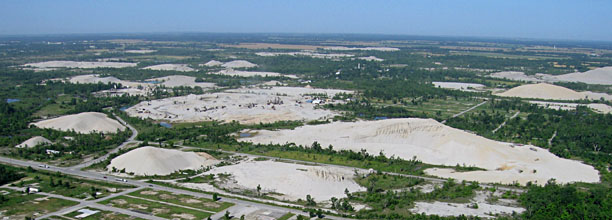
Picher, Oklahoma
Legacy of Mining
James S. and Susan W. Aber
Introduction
On July 1st, 2009, the authors had the opportunity to conduct blimp aerial photography from the top of a chat pile in Picher, Oklahoma. The word "chat" is a miner's term derived from chert (also known as flint). Chat piles are relicts of lead and zinc mines that operated in the early and mid 20th century at Picher. Large and small chat piles dominate the aerial view of Picher.
Panoramic view over Picher, Oklahoma
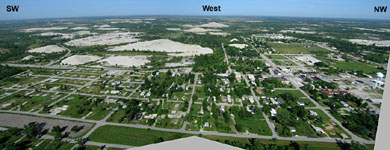 |
| Assembled from two wide-angle shots. |
Blimp operation
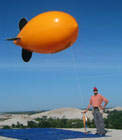
| Left: blimp inflated and ready to attach a camera rig. Right: bringing the blimp down; winding line on a Strato-spool reel.
Blimp was sent up to a maximum height of 460 feet (140 m).
|  |

| Left: Canon S70 camera rig attached to the blimp keel. Right: blimp flying with the Canon Rebel camera rig and a superwide-angle lens.
|  |

| The authors at the top of Fisher chat pile. The blimp was inflated and launched from the blue tarp behind the truck. |

| Superwide-angle vertical view on the top of the chat pile, which displays a pinwheel pattern of erosion and many vehicle tracks. |
Mining history
Picher is part of the so-called Tri-State mining district that includes southwestern Missouri, southeastern Kansas, and northeastern Oklahoma. Mining of lead ore began in the 1850s near Granby, Missouri and migrated westward in the 1870s when ore was discovered at Joplin, Missouri and Galena, Kansas (Park 2005). Also at this time, zinc production began, and eventually the Tri-State mining district produced six times more zinc than lead. These early mines were quite small, shallow, and primitive, and they were largely exhausted by the early 1900s.
In 1914 larger, deeper, and richer ore deposits were discovered at Picher, Oklahoma and nearby in Kansas. Nearly all mining took place in Oklahoma and Kansas after 1920; peak production was nearly 15 million tons of ore in 1926 (Park 2005). These mines required modern methods and equipment in order to reach the deeper ore bodies, and many small companies were consolidated into a few larger companies during the Great Depression years. By 1950 the Eagle Picher Company controlled more than half of all production in the district (Park 2005), but after World War II production gradually declined. Most larger mines ceased operating by 1957; the last mines were closed in 1970.
Mining consequences
Mining lead and zinc ore generated a huge volume of waste rock--chat, which was simply dumped on the surface in big piles. No environmental regulations existed at the time. The chat piles, water-filled mines, and former smelting sites are today sources for highly polluted water that contains heavy metals and other toxic substances. Streams, lakes, and shallow aquifers of the region are contaminated. Among the most severely impacted is Tar Creek, which drains the Picher vicinity.

| Tar Creek downstream from Picher, Oklahoma. The rusty orange color is typical of mine-water drainage and indicates a high concentration of iron and other dissolved metals. According to the U.S. Army Corps of Engineers, Tar Creek is highly toxic and, for all intents and purposes, dead. For aerial views of Tar Creek farther downstream, go to Miami, Oklahoma. |
Such contamination led to establishment of EPA superfund sites in Missouri, Kansas, and Oklahoma. Lead poisoning, especially for children, was a special concern for state and federal agencies as well as local residents. The magnitude of surface and subsurface contamination in the Picher vicinity was deemed too great for conventional remediation efforts, so the state and federal governments are in the process of buying out and relocating residents, which began with families with children. Also strongly impacted are Quapaw people who live in the area and own much of the destroyed land. Past policies of the Bureau of Indian Affairs have exacerbated the pollution problems.
As the following blimp aerial photographs illustrate, residential sections of Picher are interspersed in close proximity among and between chat piles. Thus, it would be impossible for residents to avoid lead in the airborne dust and surface water of their neighborhoods.
Superwide-angle views over Picher, Oklahoma

View southward

View to southwest

View to northwest

View northward | | | |
Wide-angle views over Picher, Oklahoma
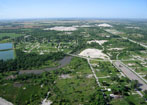
View southward

View to southwest
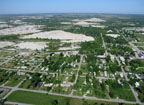
View westward
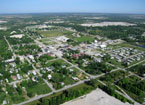
View to northwest | | | |
2008 tornado
To add further misery to the situation, an EF-4 tornado struck Picher on May 10, 2008. Six people died and 20 city blocks were destroyed by the mile-wide twister. The tornado even removed portions of some chat piles, spreading contaminated dust and debris over the area. As a result, EPA accelerated plans to close Picher, and many people had no choice but to move out. Nearly all buildings are condemned or already removed, and few businesses or governmental services remain. Picher is now virtually a ghost town; it ceased to exist officially on Sept. 1, 2009.

| Views toward southwest showing area damaged by tornado. Note lack of trees toward left, where all buildings and debris has been removed.
|  |
Related sites
Reference
- Park, J.R. 2005. Missouri mining heritage guide. Stonehouse Pub. Co., South Miami, Florida, 279 p.
 Return to KAP gallery.
Return to KAP gallery.
Last update: Sept. 2009.


















![]() Return to KAP gallery.
Return to KAP gallery.